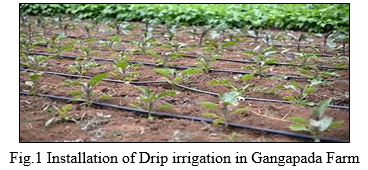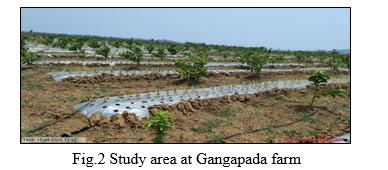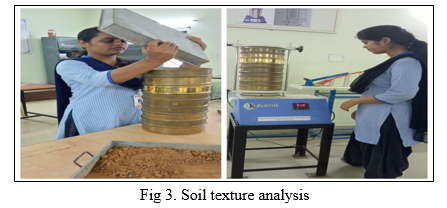Ijraset Journal For Research in Applied Science and Engineering Technology
- Home / Ijraset
- On This Page
- Abstract
- Introduction
- Conclusion
- References
- Copyright
Performance Evaluation and Wetting Pattern Estimation of Drip Irrigation
Authors: Sangeeta Mohapatra, Sonam Jena, Susandhya Mohapatra, Prof. Sushree Monali Swain, Dr. Satyananda Swain
DOI Link: https://doi.org/10.22214/ijraset.2022.42850
Certificate: View Certificate
Abstract
Population growth is increasing day by day, which leads water scarcity and food scarcity. There is big challenge on food security and crop production to maintain the demand. One solution to this problem is the use of drip irrigation system which improves profitably by increasing crop yield and quality while reducing costs from water, energy, labor, chemical inputs and water runoff. The experiment was conducted in the Gangapada farm, Khorda, Odisha. The actual discharge of the dripper having theoretical capacity 8lph was measured and the result varied in the range of 6.8 -8.15 lph. The wetting pattern also measured by constructing three beds having size 2.6 × 2 × 1 ft. The average wetting pattern was found of are 43.5, 36.3,26,12,0 cm at the depth of 0, 10, 20, 30, 40 cm respectively. The moisture content was also measured at different depth to study the variation at different depth using 8lph dripper.
Introduction
I. INTRODUCTION
A. Drip Irrigation
Drip irrigation is also known as trickle or micro irrigation as it provides waster directly onto the root zone of the plant. The main purpose of this irrigation system is to supply amount of water needed by the plant. It is an efficient irrigation method of recent origin. As it provides water directly to the plant, the evaporation loss is negligible.
B. Status of Drip Irrigation in Odisha
Odisha has a geographical area of 155707 sq. km. The total cultivated land of the state is 61.80 lakh ha and about 54% of cultivated land is irrigated. It is found that the district of Puri tops the list with an irrigation intensity of 80.79 followed by Bhadrak district with 71.91 First-Tata Steel’s solar-based drip irrigation project was inaugurated at Jhumkapatia in Bamnipal on December 18, 2016, by Mr. Nikhil Pawan Kalyan, Project Director, and DRDA Keonjhar.
C. Suitability of Drip Irrigation
Drip irrigation is more suitable for row crops (vegetables, fruits, sugarcane, and cereal crops except paddy), tree and vine crops are considered because of the high capital costs of installing a drip irrigation system. These systems are also suitable for plantation crop such as coconut, cardamom, cumin, citrus grapes and mango. For orchard crops such as grapes, Banana, pomegranate, etc. is suitable. Vegetable like tomato, chilly, capsicum, cabbage can be grown in drip Drip irrigation system can sustain in many types of soil. On clay soils, irrigation water should be applied slowly to avoid ponding and runoff. On sandy soils, higher emitter discharge will be appropriate to ensure lateral movement of the water into the soil. It can be applied to irrigate crops grown on undulating land topography and slopes where the depth of soil is limited. Drip systems in sandy soils must be carefully designed and installed to achieve good results. The soil area wetted by the dripper (known as the water ‘bulb’) varies according to soil type. In porous sands with low water retention, the bulb is long and narrow (often < 30 cm diameter). Drippers may therefore need to be spaced more closely in sands (for example every 20 to 30 cm) compared to clay soils, where the bulb diameter is much wider (often >75 cm).

II. LITERATURE SURVEY
Ne?e Üzen et al. (2013) studied the role of micro irrigation in the modern agriculture, which says the micro irrigation system is successful for the horticulture in any kind of weather condition. Which will also increase the yield of the crops, good fertilizer usage, no salinization, no disease for crops and the labor cost will also reduce.
Larson et al. (2015) experimented that the adoption of water saving technologies in the case of laser leveling and got the result, that the farmers are not adopting to the technology because of financial constraints and if the cost can be subsidizing the adoption rate. He got another result that the adoption also depends on the size of the farmer according to their landholding.
Megersa et al. (2015) determined the irrigation system of Israel and identified the most common irrigation method used for safe, efficient and sustainable agricultural production in arid and semi- arid regions of the world.
Pandya et al. (2016) examined that, the constraints in adopting the drip irrigation in the state of Gujrat, India, with the sampled farmers. It was found that high initial cost is one of the main constraints for a farmer to adopt to the drip irrigation then followed by the maintenance cost followed by the damage affected by the animals for the drip irrigation system. They got the result that, crops cultivated under the drip irrigation has productivity gain compared to surface irrigation and micro irrigation and that micro irrigation reduces the usage of fertilizer, less electricity consumption.
Aliyev et al. (2017) conducted an experiment to determine the efficiency of the irrigation with micro irrigation. He concluded that, micro irrigation is more efficient than surface irrigation in good yield of agriculture crops at the higher level of ground water.
Ahmed et al. (2017) used drip irrigation to design a greenhouse for the production of good varieties of organic seed production. He discovered that, it is better establishment of crop with higher yield to water ratio was obtained in surface irrigation method, irrespective of the varieties used under for both drip irrigation methods, it is only due to better use efficiency of sub-surface drip irrigation method.
Ramaya et al. (2017) did an experiment on automated drip irrigation, he got the result that the drip irrigation is more efficient than the conventional method as it reduces 50 % of water, monitoring and increased yield.
III. METHODOLOGY
A. Study Area Location
This experiment was conducted on drip irrigation in a farm, near Coconut Development Board, Gangapada, Bhubaneswar, Odisha. The total area is about 25 acres. Papaya, Drum stick and lemon, etc. are grown there. Garlics are grown there using intercropping. About 700 Guava plants are planted.

B. Methodology
- Methods for Measurement of soil Texture: Soil of Ganagapada farm was taken to test the soil type. After testing the result was found to be sandy loam soil.

2. Methods for Study of Performance Evaluation: This experiment was conducted for 4 days in different crops in farm. For this experiment 3 types of crops: drum stick, lemon and guava were taken. Firstly, the pressure of the pump was set to 2 and opened 4 valves to flow the water. Then we kept three different beakers under each plant individually and kept the timer set for 1hr to take the reading. Next 1 hour the pressure was set to 3.4 and opened 3 valves. Then we took the reading. Subsequently, the vertical section was cut, and then by using a scale the depth was measured.
3. Methods of Measuring the Vertical & Horizontal wetting Front of Drip Irrigation:

An emitter of 8 lph was set to feed water to the plant. Then the water was for 1 hour to flow. Exactly after, 1hr the wetting diameter of the beds was measured with a tape. After those beds were left for 24 hours. Next, the vertical wetting section of three beds was cut with a spade and by a measuring taped the reading was taken.
4. Methods for Measuring the Moisture Content: The soil samples from different vertical depth were collected. After that the weight of wet soil sample along with the tin were measured. Then 9 samples were kept in oven for 24 hours at 105degree Celsius. After 24 hours the weight of oven dried soil sample along with the tins were measured.

Then the amount of water was presented there was calculated. Next, the weight of empty tin measured and from that the weight of dry soils were calculated. Lastly, the moisture available there was measured.
IV. RESULT AND DISCUSSION
Table 4.1 Data collected for measuring actual discharge value of individual dripper
|
Sl. no. |
Days |
Sample no. |
Discharge (lph) |
|
1 |
1 |
1 |
7.5 |
|
2 |
2 |
8.15 |
|
|
3 |
3 |
7.1 |
|
|
4 |
2 |
4 |
7.9 |
|
5 |
5 |
7.8 |
|
|
6 |
6 |
6.9 |
|
|
7 |
3 |
7 |
7.8 |
|
8 |
8 |
8.1 |
|
|
9 |
9 |
6.8 |
This experiment was conducted by taking three drippers to measure the amount of water goes to the root zone of the plant in 1hour. The 3 beakers were placed under drippers and then the timer was set for 1 hour. The result was found to be 7.5 lit, 8.15 lit and 7.1 lit of water. The next day the same procedure was repeated. We observed the amount of water dripped out from the dripper followed by the dripper in 1hr. Then we got the result 7.9lit, 7.8 lit and 6.9 lit accordingly.
On third day of this experiment, the result was found 7.8 lph, 8.1 lph, and 6.8 lph respectively.
Table 4.2 Measurement of vertical and horizontal wetting pattern
|
Bed number |
Vertical depth (cm) |
Horizontal width (cm) |
|
1 |
0 |
43 |
|
10 |
38 |
|
|
20 |
25 |
|
|
30 |
18 |
|
|
40 |
0 |
|
|
2 |
0 |
44 |
|
10 |
35 |
|
|
20 |
28 |
|
|
30 |
19 |
|
|
40 |
0 |
|
|
3 |
0 |
43.5 |
|
10 |
36 |
|
|
20 |
27 |
|
|
30 |
0 |
|
|
40 |
0 |
The vertical wetting pattern of the water of the plant was measured, in the constructed bed 1. The wetting pattern at the depth of 0, 10, 20, 30, 40 was found to be 43, 38, 25, 18 , 0cm respectively. It was observed that the horizontal wetting decreases as the vertical depth increases.
The readings obtained from the second bed were like this. The wetting pattern at the depth of 0, 10,20,30,40 was found to be 44, 35, 28,19,0 cm respectively.
The readings obtained from the third bed was like this.. The wetting pattern at the depth of 0, 10, 20, 30, 40 was found to be 43.5, 36, 27, 0 , 0 cm respectively. At the depth of 30 cm the horizontal wetting was found to be zero.
C. Measurement Of Moisture Content At Different Depth Of Drip Irrigation
|
Bed no. |
Vertical depth(cm) |
Moisture content (%) |
|
1 |
0 |
15 |
|
10 |
19 |
|
|
30 |
18.5 |
|
|
2 |
0 |
18 |
|
10 |
21 |
|
|
30 |
20 |
|
|
3 |
0 |
13 |
|
10 |
19 |
|
|
30 |
12 |
In this day we took the sample from the different depth of the soil profile from the constructed bed. The moisture content at the depth of 0, 10, and 30 was found to be 15, 19, and 18.5% respectively. It was observed that the moisture content increases from top to bottom layer and again decreases.
Bed 2: In this day we did the same and took the sample from the different depth of the soil profile in the constructed bed. The moisture content at the depth of 0, 10, 30, was found to be 18, 21, 20 % respectively. It was observed that the moisture content increases from top to bottom layer and again decreases.
The moisture content at the depth of 0, 10, 30, was found to be 13, 19, 12 % respectively. It was observed that the moisture content increases from top to bottom layer and again decreases.
Conclusion
Drip irrigation is economical and cost effective as compared to conventional irrigation. Drip irrigation is the latest subsurface method of irrigating water with higher water demands in arid region. This study was conducted to know the moisture content, the actual discharge rate of an 8 lph emitter, vertical depth of the water and the horizontal depth of the water for Gangapada farm. 1) The actual discharge of dripper varying from 6.8 lph to 8.15 lph while the theoretical discharge is 8 lph. 2) The wetting front after operation of 1 hour of drip irrigation in bed 0 ,10,20,30,40 depth was found to be 43,38,25,18 ,0cm respectively 3) The wetting front after operation of 1 hour of drip irrigation in bed 2 0 ,10,20,30,40 depth was found to be be 44,35,28,19,0 cm respectively 4) The wetting front after operation of 1 hour of drip irrigation in bed 3 0, 10, 20, 30, 40 depth was found to be 43.5,36, 27,0, 0 cm respectively. 5) On an average the wetting pattern at the depth of 0,10,20,30,40 cm is 43.5,36.3,26,12,0 cm respectively. 6) The moisture content at the depth of 0, 10, 30 cm was found to be 15.3, 19.3, 16.8% respectively. It increases from top to bottom and again decreases.
References
[1] Ahmed, E. M., Barakat, M. M. A., Ragheb, H. M., & Rushdi, M. K. (2017). Impact of surface and subsurface drip irrigation systems and fertigation managements on yield and water use efficiencies of two squash varieties. Assiut J. Agric. Sci, 48(1-1), 303-318. [2] Alam, M. M., Bhutta, M. N., & Azhar, A. H. (2006, December). Use and Limitations of Sprinkler and Drip Irrigation Systems in Pakistan. In Proceedings of the Pakistan Engineering Congress, 70th Annual session, Lahore, Pakistan (pp. 2-4). [3] Aliev, Z. (2017). Studying the efficiency of irrigation with micro-irrigation. Biomed J Sci & Tech Res, 1(1). [4] Bhaduri, A., Amarasinghe, U., & Shah, T. (2006). Groundwater irrigation expansion in India: an analysis and prognosis. Draft prepared for the IWMI-CPWF project on “Strategic Analysis of National River Linking Project of India. [5] Dhanapal, R., Maheswarappa, H. P., Subramanian, P., & Upadhyay, A. K. (2003). Influence of drip irrigation on growth and yield of COD x WCT coconut (Cocos nucifera L.) hybrid. CORD, 19(02), 34-34. [6] Hussain, Intizar, Liqa Raschid, Munir A. Hanjra, Fuard Marikar, and Wim Van Der Hoek. \"Wastewater use in agriculture: Review of impacts and methodological issues in valuing impacts.\" (2002). [7] Johnson, L. F., Cahn, M., Martin, F., Melton, F., Benzen, S., Farrara, B., & Post, K. (2016). Evapotranspiration-based irrigation scheduling of head lettuce and broccoli. HortScience, 51(7), 935-940. [8] Kumar, D. S., & Palanisami, K. (2010). Impact of drip irrigation on farming system: evidence from southern India. Agricultural Economics Research Review, 23(2), 265-272. [9] Larson, N., Sekhri, S., & Sidhu, R. (2016). Adoption of water-saving technology in agriculture: The case of laser levelers. Water Resources and Economics, 14, 44-64. [10] Maisiri, N, 2004. An on-farm evaluation of the effects of low-cost drip irrigation on water and crop productivity compared to conventional surface irrigation. Unpublished Msc Thesis University of Zimbabwe. [11] Megersa, G., & Abdulahi, J. (2015). Irrigation system in Israel: A review. International Journal of water resources and environmental engineering, 7(3), 29-37 [12] Pandya, P. A., & Dwivedi, D. K. (2016). Constraints in adoption of drip irrigation. Advances in Life Sciences, 5, 2405-2411. [13] Ramya, K. M., & Saranya, M. (2017). Experimental Investigation on Drip Irrigation using Moisture Sensor. International Journal for Research in Applied Science and Engineering Technology (IJRASET), 5(VIII) [14] Senzanje,A.(1997).Developing and testing drip irrigation systems technologies for smallholder farmers. Paper presented at the “Joint International Conference on Agricultural Engineering and Technology Exhibition ‘97” held in Dhaka, Bangladesh. Dec 15-18, 1997. [15] Üzen, N., Çetin, Ö., & Karaer, M. (2013). The role of Micro Irrigation for Modern Agriculture. Toprak ve Su Dergisi Special Issue for Agricasia, 2(2), 2131-2138.
Copyright
Copyright © 2022 Sangeeta Mohapatra, Sonam Jena, Susandhya Mohapatra, Prof. Sushree Monali Swain, Dr. Satyananda Swain. This is an open access article distributed under the Creative Commons Attribution License, which permits unrestricted use, distribution, and reproduction in any medium, provided the original work is properly cited.

Download Paper
Paper Id : IJRASET42850
Publish Date : 2022-05-17
ISSN : 2321-9653
Publisher Name : IJRASET
DOI Link : Click Here
 Submit Paper Online
Submit Paper Online

